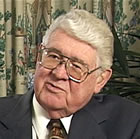
J. Willis Hurst, MD
(1920-2011)
Sad news out of Atlanta that Dr. J. Willis Hurst passed away on October 1 after a brief illness, a few weeks short of his 91st birthday. Hurst was a major figure in cardiology worldwide, having served as Professor and Chairman of the Department of Medicine at the Emory University School of Medicine for 30 years, and the author of “Hurst’s The Heart“, undisputedly the “bible” of cardiology, which is in its 13th edition and has been translated into more than five languages. It is considered to be the most widely used cardiology
textbook in the world. I know that every cardiologist’s office I’ve ever been in (and that’s a lot) has “Hurst’s The Heart” prominently displayed on the bookshelf.
Above all he was a teacher. Countless cardiologists went through his classes
at Emory and he shaped the views and outlook of many thousands of physicians. You can read more about Dr. Hurst in a letter from his colleagues, posted on the Emory website. He was a Fellow of Dr. Paul Dudley White, considered the founder of American academic cardiology, and Hurst served as President Lyndon Johnson’s personal cardiologist for 18 years.
But Hurst also had a hand in fostering what became a revolution in cardiology.
 Back in 1979, Emory cardiologist Dr. Spencer B. King, III traveled to Zurich to attend the early courses of Dr. Andreas Gruentzig to learn about his controversial new procedure called “percutaneous transluminal coronary angioplasty”. King befriended Gruentzig who expressed his concern that, unless he could keep control over the spread of this new procedure, it could be destroyed, if it were not done carefully.
Back in 1979, Emory cardiologist Dr. Spencer B. King, III traveled to Zurich to attend the early courses of Dr. Andreas Gruentzig to learn about his controversial new procedure called “percutaneous transluminal coronary angioplasty”. King befriended Gruentzig who expressed his concern that, unless he could keep control over the spread of this new procedure, it could be destroyed, if it were not done carefully.
Interest was growing rapidly and Gruentzig was looking to move to the U.S. to establish a teaching center. King suggested Emory and that is where Gruentzig landed. With significant support from Emory and the Woodruff Health Center, Gruentzig expanded the live demonstration course and, from 1980-85 in Atlanta, he personally trained the first wave of interventional cardiologists, and established the professional, scientific and ethical benchmarks of that subspecialty.
J. Willis Hurst, as Chairman of the Department, was instrumental in meeting Gruentzig’s needs, both academically and, well…check out the short video
clip below. I had the honor of interviewing Hurst for my documentary, “PTCA:
A History” and he told me what Gruentzig asked for in order to come to Emory.
J. Willis Hurst, MD discusses bringing Andreas Gruentzig, the inventor of coronary angioplasty, to Emory (:55)



